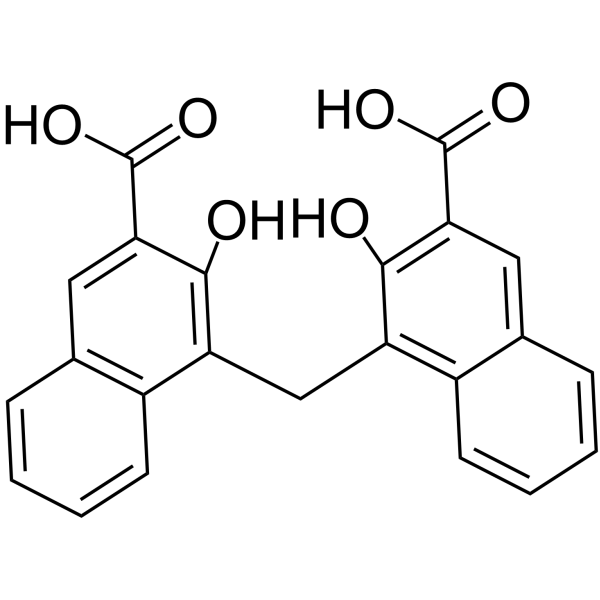Pamoic acid

Pamoic acid structure
|
Common Name | Pamoic acid | ||
|---|---|---|---|---|
| CAS Number | 130-85-8 | Molecular Weight | 388.38 | |
| Density | 1.5±0.1 g/cm3 | Boiling Point | 642.7±55.0 °C at 760 mmHg | |
| Molecular Formula | C23H16O6 | Melting Point | ≥300 °C (dec.) | |
| MSDS | Chinese USA | Flash Point | 356.5±28.0 °C | |
| Symbol |

GHS07 |
Signal Word | Warning | |
|
Long-acting atypical antipsychotics: characterization of the local tissue response.
Pharm. Res. 31(8) , 2065-77, (2014) Long-acting injectables (LAIs) are increasingly recognized as an effective therapeutic approach for treating chronic conditions. Many LAIs are formulated to create a poorly soluble depot from which the active agent is delivered over time. This long residing d... |
|
|
Identification of small-molecule antagonists that inhibit an activator: coactivator interaction.
Proc. Natl. Acad. Sci. U. S. A. 101 , 17622-17627, (2004) Phosphorylation of the cAMP response element binding protein (CREB) at Ser-133 in response to hormonal stimuli triggers cellular gene expression via the recruitment of the histone acetylase coactivator paralogs CREB binding protein (CBP) and p300 to the promo... |
|
|
Formation of stable nanocarriers by in situ ion pairing during block-copolymer-directed rapid precipitation.
Mol. Pharm. 10(1) , 319-28, (2013) We present an in situ hydrophobic salt forming technique for the encapsulation of weakly hydrophobic, ionizable active pharmaceutical ingredients (API) into stable nanocarriers (NCs) formed via a rapid precipitation process. Traditionally, NC formation via ra... |
|
|
Identification and purity determination of benzathine and embonate salts of some beta-lactam antibiotics by thin-layer chromatography.
J. Chromatogr. A. 463(2) , 469-73, (1989)
|
|
|
Identification of small molecule synthetic inhibitors of DNA polymerase beta by NMR chemical shift mapping.
J. Biol. Chem. 279(38) , 39736-44, (2004) DNA polymerase beta (beta-pol) plays a central role in repair of damaged DNA bases by base excision repair (BER) pathways. A predominant phenotype of beta-pol null mouse fibroblasts is hypersensitivity to the DNA-methylating agent methyl methanesulfonate. Res... |
|
|
Quantitative determination of pamoic acid in dog and rat serum by automated ion-pair solid-phase extraction and reversed-phase high-performance liquid chromatography.
J. Chromatogr. B. Biomed. Sci. Appl. 716(1-2) , 315-23, (1998) Pamoic acid is used as a counter ion to obtain long-acting pharmaceutical formulations of certain basic drugs. In order to investigate the pharmacokinetics of pamoic acid, a simple, sensitive and reliable method has been established for the quantitative deter... |
|
|
Effects of imipramine on ion channels and proliferation of IGR1 melanoma cells.
J. Membr. Biol. 188(2) , 137-49, (2002) Human IGR1 cells are a model for malignant melanoma. Since progression through the cell cycle is accompanied by transient cell hyperpolarization, we studied the properties of potassium and chloride ion channels and their impact on cell growth. The major potas... |
|
|
Conical precolumn as loading buffer for the main column.
J. Chromatogr. A. 314 , 183-91, (1984) A conical high-performance liquid chromatographic precolumn was developed to cope with the problems that arise during the processing of large volumes of biological samples. The shape of the column was designed so as to offer a large loading capacity at the fr... |
|
|
Structural insights on the pamoic acid and the 8 kDa domain of DNA polymerase beta complex: towards the design of higher-affinity inhibitors.
BMC Struct. Biol. 8 , 22, (2008) DNA polymerase beta (pol beta), the error-prone DNA polymerase of single-stranded DNA break repair as well as base excision repair pathways, is overexpressed in several tumors and takes part in chemotherapeutic agent resistance, like that of cisplatin, throug... |
|
|
Mind your salts: when the inactive constituent isn't.
Mol. Pharmacol. 78(4) , 558-9, (2010) Many pharmacological agents include "inactive" constituents that are used to alter the solubility, stability, or pharmaceutical properties of a drug. These "salts" are often ignored, and the "active ingredient" gets all of the attention. Pamoic acid (4-[(3-ca... |